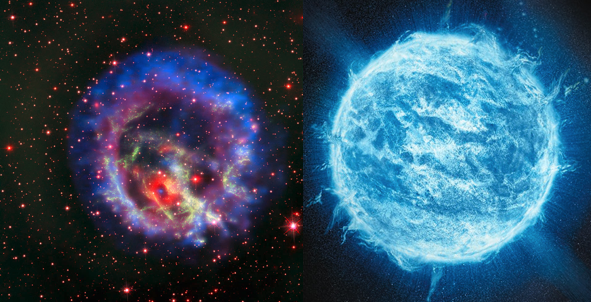Pulsars and Magnetars
The universe is home to some truly magnificent, beautiful, but also violent places. In this article, we’ll be looking at magnetars and pulsars, some of the most fascinating but chaotic things in the cosmos.
Neutron Stars
Before we get started, we have to talk about neutron stars because magnetars and pulsars are actually just different types of neutron stars. In short, a neutron star is what sometimes remains after a sun explodes in a supernova. A supernova is when a sun 10 to 40 times bigger than our own runs out of fuel, collapses into itself in a fraction of a second, and then shoots outward in an explosion that releases more energy than our sun will ever produce in its entire life! What’s left behind is a glowing neutron star. Second to black holes, neutron stars are the densest things in the universe. They have the mass of the sun squeezed into the size of a small city!
The image on the left is E0102, the remains of a supernova 200,000 light years, from Earth. There is actually a neutron star here! The image on the right is a drawing of a neutron star.
Pulsars
Now that we’re familiar with what neutron stars are, let’s dive into pulsars (but not literally dive in, because if we did, we’d be stripped into a string of atoms within a fraction of a second! That’s how strong the gravity of a pulsar is!) Basically, pulsars are spinning neutron stars, and most neutron stars that form from supernovae turn into pulsars. How does it start spinning, though? Well, if you remember, whenever a sun dies in a supernova, it is first crushed inwards before it explodes outwards. Since the sun was rotating before it exploded, the neutron star that remains after a supernova can also start to spin. The fastest rotating pulsar we’ve ever detected is one called PSR J1748-2446ad, which rotates 716 times per second!
Because of all this rotating, pulsars have a lot of energy, and this energy must go somewhere. What makes pulsars so fascinating is that this energy is converted into beams of electromagnetic radiation that shoot out from the pulsar on opposite ends.
As the pulsar spins, these beams of energy also rotate, like a beam of light spinning with a lighthouse.
So far, more than 2500 pulsars have been discovered by astronomers in our universe. In fact, only about 3000 neutron stars have been observed, which means that most of the neutron stars we know of are also pulsars. One pretty well-known pulsar is called the Crab Pulsar, which is located in the center of the Crab Nebula. The supernova that created the Crab Pulsar was actually seen and recorded by Chinese astronomers nearly one thousand years ago, in 1054!
This is the Crab Nebula. The Crab Pulsar is that bright dot in the center. You can also see the energy shooting out of it if you look closely!
Magnetars
Magnetars are another type of neutron star, and they are truly galactic beasts. While neutron stars and pulsars have magnetic fields trillions of times more powerful than the Earth’s, magnetars’ can be more than a quadrillion more powerful! That’s a thousand times stronger than pulsars and neutron stars! That’s why we call them magnetars.
Because their magnetic fields are so powerful, whenever small cracks on the surface of a magnetar occur, they cause massive amounts of energy to be released into space. This is because the crust of a magnetar is connected with its magnetic field. Changing one causes a change in the other. Events like these are called starquakes and they make earthquakes on Earth seem like nothing. In fact, in 2004, a starquake occurred on SGR 1806-20, a magnetar 47,000 light-years from Earth. In one-tenth of a second, SGR 1806-20 released more energy than our own Sun has released in the past 100,000 years!
Scientists aren’t sure exactly how magnetars form. There have only been around 30 discovered so far. But, in 2020, astronomers at Northwestern University spotted a magnetar that might have been created from a kilonova – an extremely powerful type of supernova that happens when two neutron stars smash into each other. This is exciting because it might hint that magnetars form from kilonova explosions.




